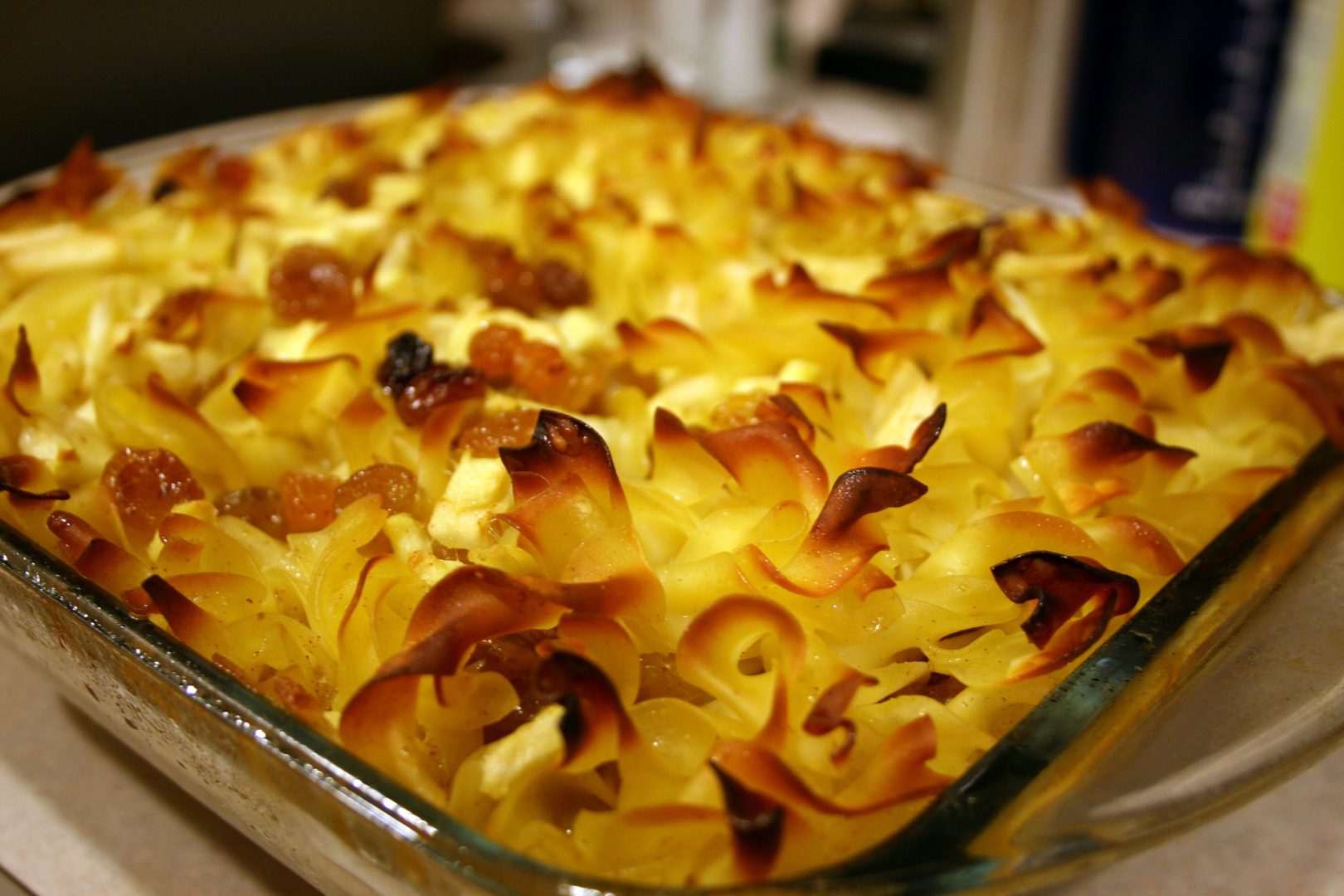“A Shabbes on Kigel iz vee a faigel on a fligel”
[The Sabbath without kugel is like a bird with no wings.]
– Yiddish proverb
Can one food be a symbol of religious devotion, national pride and even demonstrate kabbalistic powers? Those qualities and more have been attributed to kugel, a traditional pudding or casserole enjoyed on Shabbat, especially appreciated on a blustery winter’s day.
Since food cannot be cooked on Shabbat, kugel (and other dishes like cholent) are prepared before sunset Friday and can be kept in a warm oven until they are enjoyed usually on Saturday afternoon. “The first kugels were made from bread and flour and were savoury rather than sweet. About 800 years ago, cooks in Germany replaced bread mixtures with noodles or farfel. Eventually eggs were incorporated… In the late 19th century, Jerusalemites combined caramelized sugar and black pepper in a noodle kugel known as ‘Yerushalmi kugel’ or ‘Jerusalem kugel,’ which is commonly served at Shabbat kiddushes and is a popular side dish served with cholent during Shabbat lunch.”
That covers the physical side but what about kugel’s spiritual essence? The best study of the ritual and mystical significance that I have come across is Holy Kugel by Allan Nadler. When you begin reading it, it feels a bit like a parody:
Rabbi Menachem Mendel of Rimanov recalled that once, when he went out for a walk with the holy rabbi of Ropshitz, all that they talked about for three hours were the secrets that lie hidden inside the Sabbath kugel.
Reb Shmelke of Selish used to immerse himself in the mikvah [ritual bath] after the Mussaf service, before the eating of the kugel.
But then you realize that this is a serious, scholarly (but very readable) work. What may just be a tasty noodle pudding to those of us not schooled in Kabbalah took on mythic – and mystic – qualities to our progenitors. Nadler explains that when a rebbe sits down to a meal particularly on Shabbat, it is an opportunity to elevate “the sparks of holiness embedded in his food.”
READ: THE FROZEN CHOSEN: ISRAEL AT THE WINTER OLYMPICS – PART 2
But the kugel is special. “Hasidic theoreticians ‘figured out’ that kugel corresponded to the sefirah of yesod” [the Divine Attribute of ‘Foundation’] and believed it to harbour generative, or creative, powers which came directly from God. That inevitably lead to a rabbinic dispute, in this case between the 19th century Rebbes Apta and Ruzhiner: do you eat such a holy food with your hands or with a fork? Said the Rebbe of Apta, “‘How can anyone dare to take [kugel] directly from the hands of God, and so I eat the kugel with a fork.’ To this the Rizhiner responded: ‘If indeed we have this opportunity only once in the course of the week when the Holy One extends to us His spiritual influence directly with His hand, why should we not take it directly with our hands rather than use a medium?’” I’ll let you decide whether to be hands-on or hands-off.
Another tale is not attributed to the Hasidic masters but to Michael Wex, author and contemporary master of Yiddish. In Wex’s Kugel Story, we are introduced to Mrs. Yoshke Furmanovsky whose husband is enamoured with his wife’s kugel. Each week, after a generous Friday night helping, he directly falls asleep – and forgets any type of marital duties that Jewish tradition might expect of him on that holy evening. Things get interesting when the kugel takes on a life of its own in a bid to help the disconsolate Mrs. Furmanovsky. Can the kugel make things right? Read the entire story online.
The Jewish people are credited for giving the world many gifts such as ethical monotheism. But Jewish contributions don’t stop there. Although not actually a Jewish invention, who knows if the common bundt pan would ever become a household fixture if not for the Jewish pudding? In 1966, of a group of women from a Minneapolis Hadassah chapter wanted to enter a kugel in a Pillsbury Bake-Off contest. The women explained their pan requirements to the Minnesota-based Nordic Ware company and the bundt pan was born. The kugel won and the popularity of the pan soared.
Any food with roots as deep as kugel’s is sure to raise the passion of devotees. However, I know of another kugel debate that rages from time to time throughout the Jewish community. While most people know the food as “kugel,” I, however, grew up lovingly referring to it as “kigel“ thanks to my family’s Polish-Yiddish pronunciation. Jules Levin knows of the debate and recalls a Solomonic compromise that is sure to bring peace to warring kugel-kigel factions: “in our house vi call it ‘pudjing.’”
